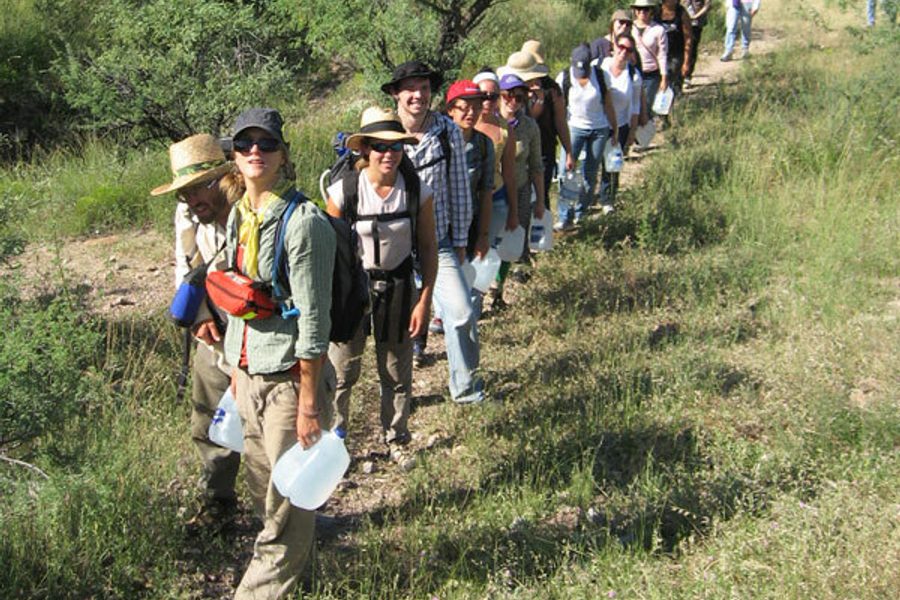Canaries in the Uranium Mine
Navajos gear up for renewed legal battle to protect their life and land
Kari Lydersen

Teddy Nez, a Navajo rancher and Vietnam War veteran, lives practically in the shadow of a 40-foot-high pile of radioactive waste abutting his small home outside of Gallup, N.M. Nez has colon cancer, which he treats with herbs – but not with ones growing near his house, because those could be contaminated with uranium.
Thousands of Navajo have developed lung cancer, kidney disease and other serious illnesses linked to uranium mining – which has supplied the U.S. government with material for nuclear weapons and power plants from the 1940s through the ’80s. (Agencies such as the World Health Organization have documented the severe health effects of uranium exposure.)
Uranium mining in the United States came to a near halt in the early ’90s because of low uranium prices, related largely to the cooling of the arms race and public disillusionment with nuclear power. But now, thanks to skyrocketing oil prices and renewed interest in nuclear energy, companies are once again planning to mine uranium in and around Navajo land.
Jeff Spitz, a Chicago filmmaker who in the late ’90s shot Return of Navajo Boy – a documentary that followed a family affected by uranium – says Navajo families at the time thought they would have to deal with only the legacy of uranium.
“No one was interested [then] except the people suffering from uranium’s effects,” says Spitz, who is working on an epilogue to the film. “After traveling down this path already, I feel like it’s about to start all over again.”
‘100 percent undrinkable’
The first U.S. uranium boom started in the ’40s before the government acknowledged that the metal posed serious health risks. It was another 20 years before the dangers were officially accepted and publicized, and it took decades more for many Navajos to get the message. Not understanding the risks, Navajo families built their homes out of uranium-tainted rocks and the crushed remains of uranium ore. Children played amid the waste.
While there was little or no opposition to the first wave of uranium mining on Navajo land, the tribe and other uranium-mining opponents are now using legal and community action to protect themselves.
The New Mexico Environmental Law Center is appealing the Nuclear Regulatory Commission’s 1998 decision to allow the company Hydro Resources Inc. (HRI) to leach uranium from aquifers that supply water to the Navajo towns of Crownpoint and Church Rock in western New Mexico.
Instead of taking the uranium-laced ore from the ground, HRI is hoping to use a process – called in situ recovery (ISR) or in situ leaching (ISL) – that involves injecting oxygenated water into uranium-laden aquifers to bond with the uranium and allow it to be pumped out. Although it is less disruptive and waste-producing than traditional mining, critics say it could easily contaminate the water supply because it destabilizes uranium in the aquifer.
“Fifteen thousand people depend on that water supply for their domestic and agricultural needs,” says Eric Jantz, the lead attorney in the appeal. “There is a 100 percent chance it will be undrinkable afterwards.”
Randy Foote, New Mexico operations director for Texas-based Uranium Resources Inc., Hydro Resources’ parent company, asserts that the aquifers will be cleansed with reverse osmosis treatments, returning the water to its pre-mining condition. Jantz doesn’t buy it.
“With in situ mining, the aquifer is intentionally polluted, and they can never get all the uranium out,” he says. “There has never been a successful restoration of an ISL aquifer. That aquifer becomes a sacrifice.”
Jantz’s appeal also argues that the amount Hydro Resources plans to set aside for restoration is too low. The company proposed a $9 million restoration fund for one section of the project. It would have to put down only a third of that up front. But an expert contracted by the New Mexico Environmental Law Center says it could take close to $24 million to adequately restore that site.
“One of two things would happen,” says Jantz. “Either taxpayers would be stuck with the bill. Or, the more likely scenario is it just wouldn’t get cleaned up.”
In 2005, the Navajo Nation banned uranium mining and milling on its land, and in 2006, an Indigenous World Uranium Summit was held at the Navajo capital of Window Rock, about 150 miles east of Flagstaff, Ariz.
Uranium Resources and other companies seeking to do business in New Mexico stress they are looking only at private land. But the area they want to mine has a complex patchwork of subsurface mineral and water rights that underlie an already complicated checkerboard of tribal and non-tribal land. Tribal leaders argue their ban should prevent these proposed operations.
The U.S. 10th Circuit Court of Appeals is currently deciding whether the Crownpoint and Church Rock sites – where Uranium Resources wants to conduct in situ mining – is tribal land.
A legacy of waste
Three-quarters of the more than 1,000 uranium mines that once operated in the area have not been cleaned up, according to the Southwest Research and Information Center, a nonprofit advocacy group. Most of the mining companies pulled up stakes without ever cleaning their waste.
Because these companies sold uranium to the U.S. government, people have long argued that the government should be taking care of the environmental cleanup. The Environmental Protection Agency (EPA) has spearheaded some efforts, but piles of uranium waste are still scattered throughout large swaths of Arizona, Nevada, New Mexico and Utah.
The EPA is creating draft action plans regarding uranium on the Navajo Nation. But in a January letter to the agency, House Committee on Oversight and Government Reform Chairman Rep. Henry Waxman (D-Calif.) said the draft lacks a clear course of action. Instead, Waxman proposed a five-year multi-agency plan, including mine cleanup, case studies on adverse health effects and an examination of alternative water supplies.
In response to public and governmental pressure, Uranium Resources and other companies plan to pay into a “legacy fund” for cleanup of past uranium mining, though they emphasize they are not the ones who created the mess. The amount they would pay is up for debate.
This spring, New Mexico Gov. Bill Richardson (D) vetoed a bill that opponents described as “industry-friendly.” It would have mandated new mining operations pay 50 cents per pound of uranium harvested into this legacy fund. With uranium prices reaching highs above $100 a pound in the past year, many call the amount proposed in the bill too low.
The federal government didn’t enact guidelines to protect uranium workers from dangerous exposure until 1971. But many former miners say they worked in dirty conditions without safety equipment even after the measures passed.
“We had no respirators, you’d have sweat running down your face with the uranium dust getting in your ears, nose and mouth,” says Larry J. King, a Navajo rancher who worked in New Mexico uranium mines from 1975 to 1982. “You couldn’t help but swallow it.”
In 1990, Congress passed legislation to give $100,000 payments (later raised to $150,000) to uranium miners – many of them Navajo – who were working prior to the 1971 regulations. As of June 2007, 4,560 miners had received $455 million. (Congress also created payments for uranium ore transporters and millers, as well as for people in parts of Arizona, Nevada and Utah who were exposed to radiation from nuclear weapons testing.)
But in 2000, the fund ran out of money, and many miners died while waiting for payments. The fund has since been replenished, but victims say that red tape makes receiving payment claims too difficult.
Global and local trends
Companies are now seeking uranium mining and milling permits in Colorado, South Dakota, Utah, Wyoming and other states. An estimated 660 million pounds of uranium remain in the ground in New Mexico, and at least five companies want to begin mining it.
Uranium Resources hopes to mine 100 million pounds of uranium it owns the rights to, including deposits near Crownpoint. It is also looking to purchase a former Kerr McGee uranium mill in Ambrosia Lake, N.M., to refine uranium ore from traditionally mined deposits.
For the ISR project, Uranium Resources has partnered with Itochu Corp., a Japan-based multinational company with investments in sectors that include textiles, machinery, energy and chemicals.
These global economic trends are not primary concerns to Nez. But the effects he sees on his dusty little farm are.
He shows visitors large color photos of lambs born abnormally – bright pink and hairless, with yellow eyes. Many of them die soon after birth. He attributes this to uranium in the drinking water.
Nez says people often ask why he doesn’t move away from the contaminated land. But, he replies, this is his people’s land, and he can’t imagine himself anywhere else.
“I’m not leaving. I just want them to clean up this pile of uranium.”
Kari Lydersen is a Chicago-based journalist, author and assistant professor at Northwestern University, where she leads the investigative specialization at the Medill School of Journalism, Media, Integrated Marketing Communications. Her books include Mayor 1%: Rahm Emanuel and the Rise of Chicago’s 99%.







